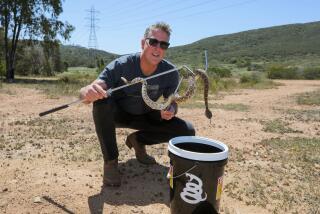A Little Studying Pays Off as Skunks Make Scents of It All
- Share via
A few friendly tips to make life, if not more pleasant then at least less noisome, over the next few months: Don’t root around beneath your house. Don’t trail grubs into your living room. Strap canisters of tomato juice to your belt. Wear goggles. Warn your children and dogs to avoid other mammals, in particular certain New World omnivorous mammals of the weasel family, Mustelidae.
If prudence prevails, you’ll emerge from the annual blitzkrieg of skunks into the San Fernando Valley smelling like a rose.
If prudence fails, however, you could be drenched with a brew so powerfully foul it’s reputedly been sniffed by sailors 20 miles offshore, so long-lasting that traces of it have been known to linger on museum specimens more than a century. Even worse, a parasitic roundworm could infest your brain. You could be temporarily blinded. Or you could be infected with rabies.
The chances of such a crippling or lethal encounter are minuscule. But be wary. This is the season of the skunk.
Over the past few weeks, they’ve been emerging from an on-again, off-again winter’s sleep in burrows and in brush. They’ve been mating, and even now they’re seeking out an eclectic range of places to bear their broods of two to 10, from within the plastic caress of swimming-pool filters to the dark, soft, tranquil crawl spaces beneath houses.
All over Southern California, the skunks are stirring. The lush and isolated Palos Verdes Peninsula is a particular haven, say animal officials, but the Valley also is favored territory.
Dennis Kroeplin, the city Department of Animal Regulation’s lone wildlife officer for the Valley and its environs, now receives about a call a day from homeowners upset about the proximity of skunks. When the season reaches its peak in a couple of months, and hungry skunk families start their nocturnal foraging for grubs and bugs and field mice in gardens and yards, Kroeplin will field 30 calls a week.
He has seen man pitted against skunk time and again, and most often, he has seen man lose. He has seen lawns torn up “like a really horrible golfer had been there.” He has toured houses that have reeked for weeks, despite all deodorant efforts. He’s known dogs to be blinded, and even bore witness to skunk-spurred marital discord.
“One guy up in the Hollywood Hills told me he’d lose his wife if I didn’t get the skunks off his property,” Kroeplin reminisces. “He’d gotten home late one night, and found this skunk family rooting around at the top of a steep walkway right in front of his front door. He didn’t know what to do, so he spent the night in a motel and had to explain it to his wife in the morning.”
A woman who was six months pregnant and a recent transplant from New York never had seen a skunk before she saw one in a trap Kroeplin had set in her yard. “She thought it was a raccoon and she handed it a cookie,” Kroeplin recalls. “She promptly got sprayed, which made her extremely nauseated, and rushed to the hospital to make sure nothing happened to the baby.”
Tomato Juice Helps
Nothing did--but the incident underscores the cardinal rule animal experts offer for dealing with skunks: Back off. Skunks can squirt as far as 15 feet. A good dousing with tomato juice dissipates the odor, but their fluid, which has been likened to Mace, stings the skin and burns the eyes. And skunks don’t scare.
“Griffith Park is loaded with them,” says Tony Valenzuela, curator of mammals at the Greater Los Angeles Zoo, “and they’re very brazen.
“They’re opportunistic. I’ve seen them at night in the snow leopards’ enclosure, going after the food we set out. I’ve seen them with ravens, with eagles, with hawks, with almost every animal you can think of, and 99% of the time, they’re left alone. They’re slow-moving, but they don’t need the speed. They’re self-assured enough to know they won’t be messed with.”
Can Be Ferocious
With good reason. In addition to their loathsome odor, skunks possess sharp teeth and claws, and explosive dispositions, although they usually strike only when provoked. “They’re aggressive,” says Valenzuela. “They can be quite ferocious.”
Besides, they can transmit rabies.
That’s why Kroeplin and other animal control officers use chloroform-soaked sponges to kill the skunks who make their way into the traps they lend to homeowners. The bodies--Kroeplin alone chloroforms about 100 skunks a year--are taken to the county veterinarian’s office for examination.
Ever since a fire ravaged some prime skunk habitats in the Malibu hills in 1970, not one rabid skunk has been found in Los Angeles County, according to Dr. Eric Hughes of the county veterinarian’s office. But rabid skunks have been found in Northern California and as close as Santa Barbara, and authorities are taking no chances on rabid skunks here spreading the disease to wildlife, pets or people. “I’d be concerned if the trapping program were to stop,” said Hughes. “Overpopulation makes animals even more susceptible to diseases.”
Harbors Roundworm Larva
So trapped skunks are dead skunks, and researchers scrutinizing the remains discover even more nastiness. “A child playing where a skunk has defecated, and ingesting it, can come in contact with a parasitic roundworm larva that migrates to the brain,” says Hughes. “It can be fatal.”
Kroeplin, the last human being many a skunk will ever attempt to spray, has a certain sympathy for them.
“We’ve pushed them back a little ways into the hills,” he says, “and they’re just coming back to their old stomping grounds looking for food and water.”
“After all,” he says, “they were here first.”







